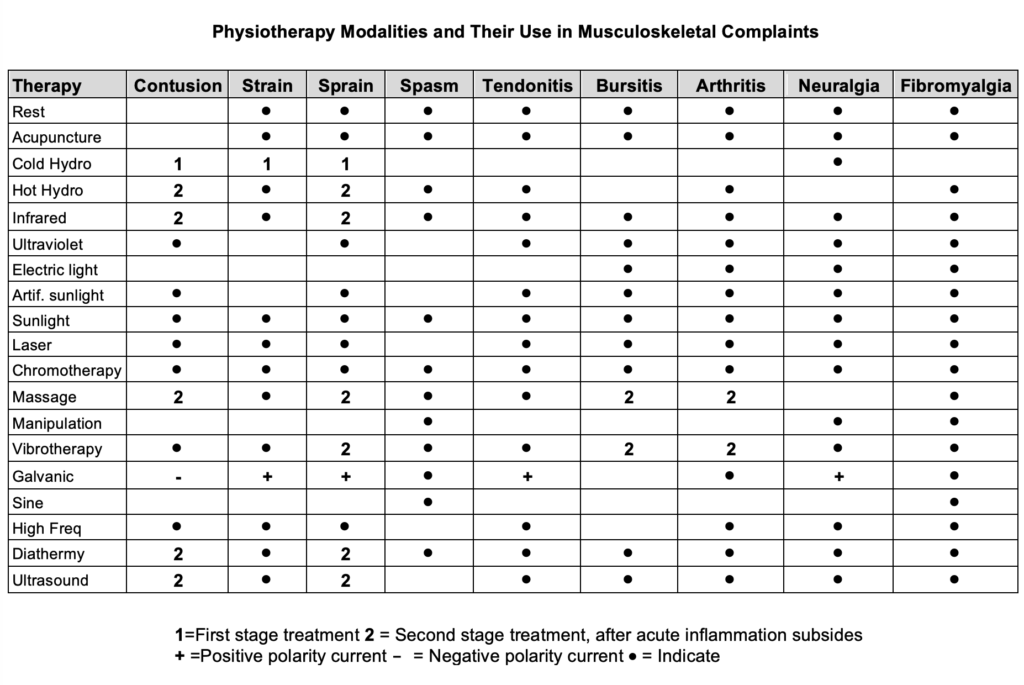A Guide to Physiotherapies in the Protocols
Traditional Naturopathic practice has historically made use of a variety of physiotherapy methods. Some are today shared by conventional medical and physical therapy practice, some by Osteopaths and Chiropractors; some appear in massage practice, and some have disappeared from sight in all of these fields.
Historically, all of these modalities have been used successfully for a wide variety of conditions. Many of them today are thought of only in light of musculoskeletal conditions, but they have all been effectively applied to organic disease as well. When one consults the protocols in this book, there will be recommendations for the various therapies as they apply to the condition under discussion. Where one does not appear, it is because there was found no record of successful use in that illness.

Here is a brief rundown of the modalities mentioned in this book:
HYDROTHERAPY is used in conventional physical therapy and as an adjunctive modality in massotherapy. Naturopaths raised it to a high art and used it effectively for systemic conditions, not only musculoskeletal ones. The effects of hydrotherapy are partly thermal, partly hydratic. As with other modalities, how it is applied determines its range of action. The Neo-eclectic doctor will not ignore this potent weapon against disease.
ELECTROTHERAPY contains a number of different modalities. Some use electrical current applied directly to the skin; others have an indirect application. A brief list of categories:
⌲Acupuncture point or trigger point stimulation (in both milliampere and microampere strengths);
⌲Stimulation using conducting pad electrodes to cover larger areas (sine wave, galvanic, low voltage, high voltage, interferential, Russian microwave resonance therapy, etc.);
⌲High-voltage, high frequency brush or plasma discharge (Oudin current, “violet ray”, Rife plasma tube resonators, etc.);
⌲Electromagnetic field generators (long wave diathermy, short wave diathermy, microwave diathermy, ultrasound diathermy).
PHOTOTHERAPY is a broad term, but one that is used for convenience in assembling the various technics for treating disease with the part of the electromagnetic spectrum consisting of visible and invisible light. It includes:
⌲Chromotherapy, a method of using filtered light to apply color to the body. Colors represent specific bands of the spectrum that have specific therapeutic applications;
⌲Infrared applications (long wave or far infrared, and short wave or near infrared);
⌲Ultraviolet applications; the use of actinic rays (light that causes chemical changes in the tissues) to treat disease and increase the nutritional uptake of the skin;
⌲Broad- or full-spectrum light, applied to the skin to offset light deficiency during periods of reduced exposure to sunlight;
⌲Heliotherapy, the use of measured exposure to direct sunlight;
⌲Cold laser applications (helium-neon, argon, etc.), either to specific points as in acupuncture points, or larger affected areas, to relieve pain and inflammation.
MANUAL THERAPY comprising a variety of categories, and sub-categories based on specialized technics, which have a hands-on application:
⌲Massage and all its various technics, which cross over into the next group:
⌲Soft tissue technics, including Zone Therapy or Reflexology, manipulative reductions (“Bloodless Surgery”), visceral manipulation, Bowen Therapy, Trigger Point Therapy and Myotherapy, etc.
⌲Joint mobilization or manipulative technics. Although superficially similar to Osteopathic and Chiropractic maneuvers, many Naturopathic manipulations differ substantially in execution. Divided broadly into impulse and non-impulse movements.
⌲Spondylotherapy, a method of applying concussion to specific spinal segments to create a neurological response without manipulating the spine.
⌲Vasopneumatic Therapy using vacuum applications to the skin.
VIBROTHERAPY or mechanical vibration is the application of oscillations to the body from a vibrating apparatus, causing waves of vibration to move through the tissues. Achieving many of the effects of massage, this modality acts more rapidly and efficiently than an operator’s hands, sending hundreds of impulses to knead muscles, drain fluids from tissues, draw blood to an area, release trapped substances, etc.
ACUPUNCTURE is a modality that was incorporated into Naturopathic education in recent years. Oriental medicine (of which acupuncture is but a part) is a full-fledged study in its own right, and very nearly overlaps Naturopathic medicine in its content. One difference is that while the Western system has historically used implements to put pressure on reflex points, the Eastern system has traditionally used needles and called them acupuncture points. Naturopathic medicine has borrowed acupuncture knowledge in the modern era just as many acupuncturists are now using infrared lamps and other long-used Naturopathic modalities.
In the Acupuncture section, suggested stimulation is differentiated by (s) for sedation, (t) for tonification, (n) for neutral, and (moxa) for moxibustion. The nomenclature for the meridians is the abbreviation system currently in use throughout most of North America:
LU = Lung
LI = Large Intestine
ST = Stomach
SP = Spleen/Pancreas
HE = Heart
SI = Small Intestine
UB = Urinary Bladder
KD= Kidney
PC = Pericardium
TW = Triple Warmer
GB = Gall Bladder
LV = Liver
There may be more than one point formula recommended. In such cases, they are referred to as “Tx #1”, “#Tx #2”, etc. The #1 treatment plan should in most cases be tried first. If there is slow response (i.e., no improvement within three sessions), the next treatment formula should be implemented. Of course, the best results are gained by a carefully chosen set of points based on the review of the complete individual picture of the patient. The suggested courses of point treatment in this section are based on many of the most reliable point formulas listed in the “sacred formulas” as well as the more modern research of European leaders in the field. When points are recommended that are not well known in the traditional acupuncture field, links are included to reference the points.